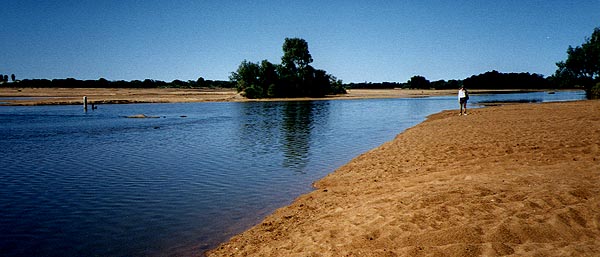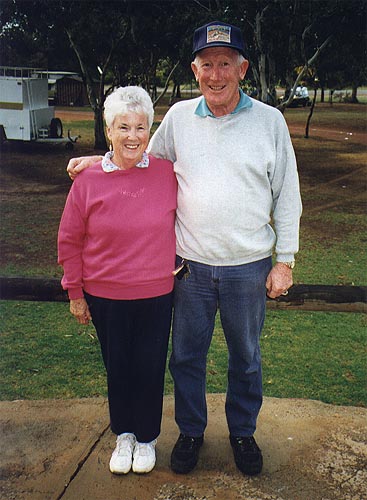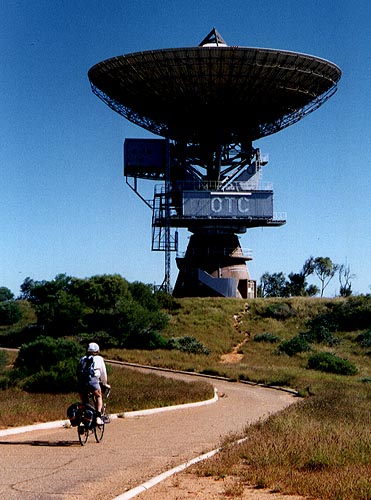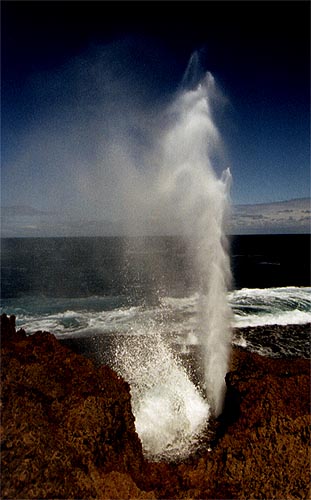|
Karen and I left Minilya at 7:30am. We covered twenty one kilometres in the first hour before a southerly wind hit us and forced our average speed down to about twelve kilometres per hour. The riding was miserable, the headwind strong and cold, and a couple of sharp rain squalls did not improve the situation. We cut our normal five kilometre lead swaps back to only two kilometres so the person in front could have a more regular break.
By midday we had only ridden a paltry sixty kilometres, and a signpost saying we had reached Booloogooro Station was a good excuse to stop for a rest. Three weeks earlier, at the Fortescue River Roadhouse, the sister of the owner of the station had told us that we could get water at Booloogooro if necessary, and Karen and I had rationed our water accordingly. We pushed our bikes along the soft dirt road to the main homestead building and parked Elle and Mel against the fence. A cute little poddy calf greeted us at the gate as we walked up to the front door, water-bottles in hand.
Jo met us at the door and after we explained who we were and what we were doing, she invited us in for a cuppa. The cuppa quickly turned into pumpkin soup as well, and an offer of lamb sandwiches which we could not refuse. Various people wandered in and out of the kitchen, helping themselves to whatever was on offer. During lunch Karen and I were introduced to other family members, assorted workers, and a variety of kids. Jo told us that a lot of touring cyclists dropped into the property from time to time, and then stunned us by offering accommodation for the night. With the wind showing no sign of letting up, and Carnarvon still seventy odd kilometres away, we accepted the offer gratefully.
Jo pointed us towards a schoolhouse on the hill, which had a couple of spare bedrooms at one end. We pushed the bikes up to the building and introduced ourselves to the resident school teacher and her class of two. She showed us our room, told us where the other facilities were located and left us to our own devices. The room was typical country, with lace curtains and a big, soft double bed.
The wind had blown away the rain, so I spent the afternoon drying our tent and some of our gear which had been soaked in the back of the trailer on the way down from Exmouth. I also adjusted Elle's rear derailleur which had started to make a few noises it shouldn't. In the late arvo Karen and I packed up all of our dry gear, had a couple of glasses of wine and a shower, and walked down to the homestead to try to talk them out of offering us dinner, which we knew was likely.
We failed miserably, our hosts insisting we share their pea soup, and curried lamb and rice. Karen even accepted their offer of cake for dessert. Then Bob brought out a bottle of Rhine Riesling and asked us if we would like a glass or two. No one else on the property drank the stuff, he claimed, and he did not like to drink alone, so with our arms well and truly twisted, we agreed to help him out. We also helped him with a bottle of chardonnay as well. The lamb sandwich lunch and curried lamb dinner had made it obvious that Booloogooro was a sheep station. We spoke at length to Bob and Jo about their life on the property, talking about shearing and mustering, the latter now done using planes and motorbikes rather than horses.
Dinner was attended by lots of family members like kids and nephews, and also by a couple of visiting New Zealanders. After dinner Bob and Jo brought out a visitors book which we were invited to sign! The immediate family and Karen and I piled into a television room to watch the usual night-time stuff after dinner. We watched for a little while but Karen and I retired to bed shortly after nine.
Our relentless progression southward was evidenced by yet another cool night. August was upon us and the tropics had now been left behind. Gone were the days of lying naked on top of our sheets. The small room and soft bed helped to keep us warm, and a bit of snuggling together did not hurt either.
We woke at 5am, shortly after the generator started up. Through the window beside the bed we searched for and found the fading haze of the Hale-Bopp comet, almost imperceptible against the nearby radiance of Sirius, the brightest star in the night sky. After a quick pack-up we pushed our bikes down the hill to the homestead, where we were breakfasted on hot tea and Wheat Bix. A quick read of the daily paper was followed by goodbyes to our hosts, who had showed us what true country hospitality is all about.
Karen and I were riding by 7:45am, hoping to put in some distance before the wind hit us again. When we left Darwin we had known that we would have following winds all the way to the north-west tip of Western Australia, and that from there down to Perth we could expect winds from the south. Like most winds, however, they would be stronger in the afternoons, so our strategy was to get out on the road in the morning as soon as we could. The strategy was working on this day, with still, cool and cloudless conditions.
We rode through flattish, low scrub, with buffel grass everywhere and a few early season wildflowers scattered amongst it. Pools of surface water from the recent rains were common, a haven for the songbirds that brightened our day. We were entertained by the familiar voices of Crested Bellbirds and Rufous Songlarks, but a different voice soon became evident. Within a few minutes Karen and I had another new bird - the Brown Songlark.
The wind put in an appearance just before morning tea, coming in from the east but turning south-east later on. We stopped at a parking bay to boil the kettle and were soon joined by a northbound cyclist named Mark. He had cycled from just north of Albany through Perth to Carnarvon, which he had left this morning. Darwin was his initial goal, and then maybe down through the centre and across the Nullarbor back to his Mount Barker home. Mark had been making pretty good time up the coast, and we did not have the heart to tell him that the following breezes he had been enjoying would soon be replaced by three thousand kilometres of headwinds. He would soon find out anyway. Before we went our separate ways, Mark recommended the Marloo caravan park in Carnarvon.
The marginal sheep land we had been traversing disappeared one kilometre from the Gascoyne River. The transformation from grazing country to farms and plantations was sharp - it is amazing what a difference water makes. When I had passed this way in 1975, the river had been dry, apart from a pitiful puddle on the north-western side of the bridge being sucked dry by an irrigation pump. This time the river had water in it, but we soon learned that the river flowed all year round. Sometimes the water flowed over the sandy river bed, and sometimes the water flowed through the sandy river bed.

The mighty Gascoyne River
Like all of the coastal towns of the north-west, Carnarvon is off the main highway. Wyndham had been fifty six kilometres from the highway, Derby forty two, Broome thirty four and Exmouth two hundred and twenty. Only a few had been a handful of kilometres from the highway, like Port Hedland and Karratha. Karen and I were glad that Carnarvon was also of the latter variety. We soon arrived at the Marloo caravan park where we paid for a couple of days accommodation, set up our tent next to a superb campers kitchen, and bumped into Bill and Betty from the Derby pier day and the Neil McLeod tour. We promised to catch up with them later.
In mid afternoon we walked the remaining three kilometres into town to shop for dinner and to pick up some mail which had been redirected to us by Karen's dad. Outside the tourist bureau I found a small wallet containing a ten dollar note and, unfortunately, lots of identification as well. After examining a local street directory, we discovered we would pass the home address of the owner of the wallet on our way back to the caravan park. The wallet belonged to a young aboriginal girl with the rather apt name of Ebony.
Mark had obviously recommended Marloo because of the quality of the campers kitchen. We watched the news on television as we microwaved a meal of vegetables and pasta in mushroom and garlic sauce. Afterwards, we devoured our mail. News from home always made us feel good - it was good to know that we had not been forgotten.
A cool night produced loads of dew from the lush grass in the camping area. Neither Karen nor I wanted to get up early so we slept through our alarms and woke at 6:45am. After brekkie in the campers kitchen we packed the bikes in readiness for a tour of the town then walked down to Site Eighteen to speak with Bill and Betty Burgess. They showed us the photos they had taken during their holiday, which was a luxury Karen and I had not experienced. We always mailed our finished films to a photo processing company in Queensland who then sent the prints to Kevin in Wheeler Heights. It would have been nice to see our photos as we went, but it was pretty good to see all of them at the conclusion of a leg too.

Betty and Bill
We must have said some pretty nice things about their photography, because Bill invited us along on a day trip to Point Quobba, about fifty kilometres up the coast. They would not be going until Saturday, which would give us a couple of days to see the sights of Carnarvon in the meantime.
It was 10am by the time we had finished talking to Bill and Betty. Karen insisted we have morning tea before we left the caravan park, so we did not get into Carnarvon until eleven. We rode out to near the mouth of the Gascoyne and onto the first part of the One Mile Jetty where a fence prevented access to much of the deteriorating structure. In the dunes behind the beach we heard and then saw a couple of Horsfield's Bronze Cuckoos, not a new bird, but one not often seen. We followed the coast down to Pelican Point and then cycled to the town beach for a lunch of fish and chips. After lunch we cruised around the boat harbour, and spotted a new bird on the mangrove mudflats - a Greenshank. On the way back to the caravan park we stopped at Chinaman's Pool, a water-filled section of the Gascoyne. By mid afternoon almost all of Carnarvon's scenery had been exhausted.
I searched for the comet at 4:30am the next morning but I was up about an hour too early. After a brekkie of oats and muesli Karen and I prepared our bikes for a short ride out to a banana plantation which held regular tours. "Preparing the bikes" means that we take anything of value off them, like pumps, water-bottles, computers and lights, and store them in the tent. It is arguable whether the removed items are any safer in an unlocked tent in a caravan park than on bikes chained together at a banana plantation, but we never had anything stolen during all of our travels, so we must have been doing something right.
Just prior to the tour we ordered our lunch for afterwards - mango beef nachos for me and a variety of (very healthy) scones for Karen. The one hour tour was informative, illuminating and interesting. Did you know that bananas are actually herbs, and that most of the plant is actually below the ground, except for the leaves? Did you know that the bananas are initially formed near the ground and that they rise up through the middle of the stem? Did you know that when the bananas reach the top of the plant, their weight causes the stem to fall over and the hands to point downwards? Did you know that by the time the hands are fully developed, they point upwards? Did you know that only one bunch of bananas is produced by one stem? Well neither did I!
Just prior to the tour we had unexpectedly run into Bill and Betty again, so we joined them for lunch afterwards. We then headed back towards town, stopping at a couple of plantations on the way to buy some fruit using the honour system. We also stopped at a ford over the Gascoyne, where a sign informed us that the ford was closed. A local explained that the closure was due to the river actually flowing - a relatively uncommon occurrence.
On a hill near the Carnarvon turn-off stands an impressive radio dish emblazoned with the initials OTC - Overland Telecommunications Company. Karen and I rode up to the top of the hill for a quick look. When I had passed this way in 1975, the dish had been fully operational, a vital link in Australia's communications with the outside world. Now it stands derelict, a testimony to the speed of the development of the information age.

The OTC dish
Our third day at Carnarvon started with a 5:30am search for Hale-Bopp, now almost invisible and getting fainter by the day. The comet was now millions of miles away and heading out of the inner Solar System, so it was not about to get any brighter. I decided that today would be my last Hale-Bopp watching day. I would not look for it again.
Today would be our jaunt up the coast to Point Quobba with Bill and Betty, so Karen and I were up again at 7am to prepare for a day away. After pegging a load of washing out to dry, we shopped at the supermarket next door in readiness for leaving Carnarvon the following day, and we were ready to go when Bill and Betty picked us up in mid morning. The drive to Point Quobba was mainly through sandy saltbush. We skirted around a salt lake called Lake Macleod which had a bit of water in it and looked more like a normal lake.
Point Quobba is famous for its blowholes. When we arrived in the carpark we could easily see that the blowholes were working. We walked out onto a rocky ledge and looked down at a lower shelf containing one large hole, almost a metre wide. Water bubbled up through the opening with every wave that rolled in, but it was a smaller blowhole neighbour which was putting on the show, blowing water thirty or forty metres into the air. A few metres away was a ring of six holes which bubbled away and blew small jets of spray a foot or two high as a precursor to the eruptions of the two main holes.

The Point Quobba blowhole
We returned to the car for a seven kilometre drive further north to a monument high on a ridge above the ocean. It was dedicated to an Australian warship, the Sydney, which was sunk in this area by the Germans during the Second World War. Far out to sea, the waters where all six hundred and forty of the Sydney crew were lost now played host to migrating whales, their tell-tale spouts visible to the naked eye. Binoculars revealed distant backs and occasional tails.
Another twenty or thirty kilometres up the coast we came to another lookout. To the south we could see the glistening, white cones of salt and gypsum in the ship loading area for the Lake Macleod mines. Directly below us was a rusting hulk, the wreck of the Korean Star which had washed up on the rocks in 1988. To the north, more whale spouts were visible in the bay. It was a fascinating juxtaposition of industry, scenery, history and nature.

The wreck of the Korean Star
On our return journey to Carnarvon we stopped at the Point Quobba lighthouse. A nasty, black bank of cloud was approaching, and heavy squall of rain hit us hard as we neared the town. When we arrived back Karen and I failed to notice that the clothes line was bare and that all of our washing was gone. It was not until a woman in a neighbouring caravan handed Karen a pile of clothes and said she had taken them down just before the rain had hit, that we realised our washing was no longer on the line. Once again we had been given a demonstration of the kindness of strangers.
With more days on the road looming, I tried to cram in as much television watching as possible. So desperate was I for a bit of sport that I even watched a Westar footy match, the local Western Australian competition. I followed this up with a women's basketball telecast, some news, and an AFL game between Richmond and Fremantle.
In the morning the forecast south-westerly winds were so strong that we decided to stay for another day in Carnarvon. We spent the entire day around the caravan park, watching the Swans lose to St. Kilda and Adelaide beat Port Adelaide in a South Australian local derby. Karen and I spoke with lots of people - Bill, Betty, some Pommie tourists, and couple we had met in Katherine in April, four months earlier! Late in the afternoon we walked down to Site Eighteen to look at the photos Bill and Betty had taken of yesterday's trip to Point Quobba. Their blowhole pictures were excellent. I hoped that ours would be as good.
The evening weather report predicted light and variable winds for the next day, so our return to the road was imminent. Karen decided that she had better get some television time under her belt as well, so she sat up late watching a movie entitled The Vanishing. When she finally came to bed, she told me the night had turned really cold. I had not noticed, because I was as snug as a bug in a rug listening to the Aussies win not only the fifth cricket test, but the entire Ashes series.
In the morning I packed up a dewy tent and we were ready to leave shortly after eight. Karen gave Bill and Betty a four litre container of water to drop at the Edaggee rest area. Peter and Mihkala were supposed to have dropped eight litres at Edaggee as well, but there is a lot of nothing south of Carnarvon so Karen and I had decided to hedge our bets and make sure of our water supply. We had two hundred kilometres to ride to reach the Overlander Roadhouse. From there we intended leaving Highway One yet again for another little side-trip.
Ever since Karen was a little girl, she had always yearned to visit the dolphins at Monkey Mia. From the Overlander Roadhouse she would almost be able to hear their calls - a mere one hundred and fifty kilometres away around the shores of Shark Bay.
|




